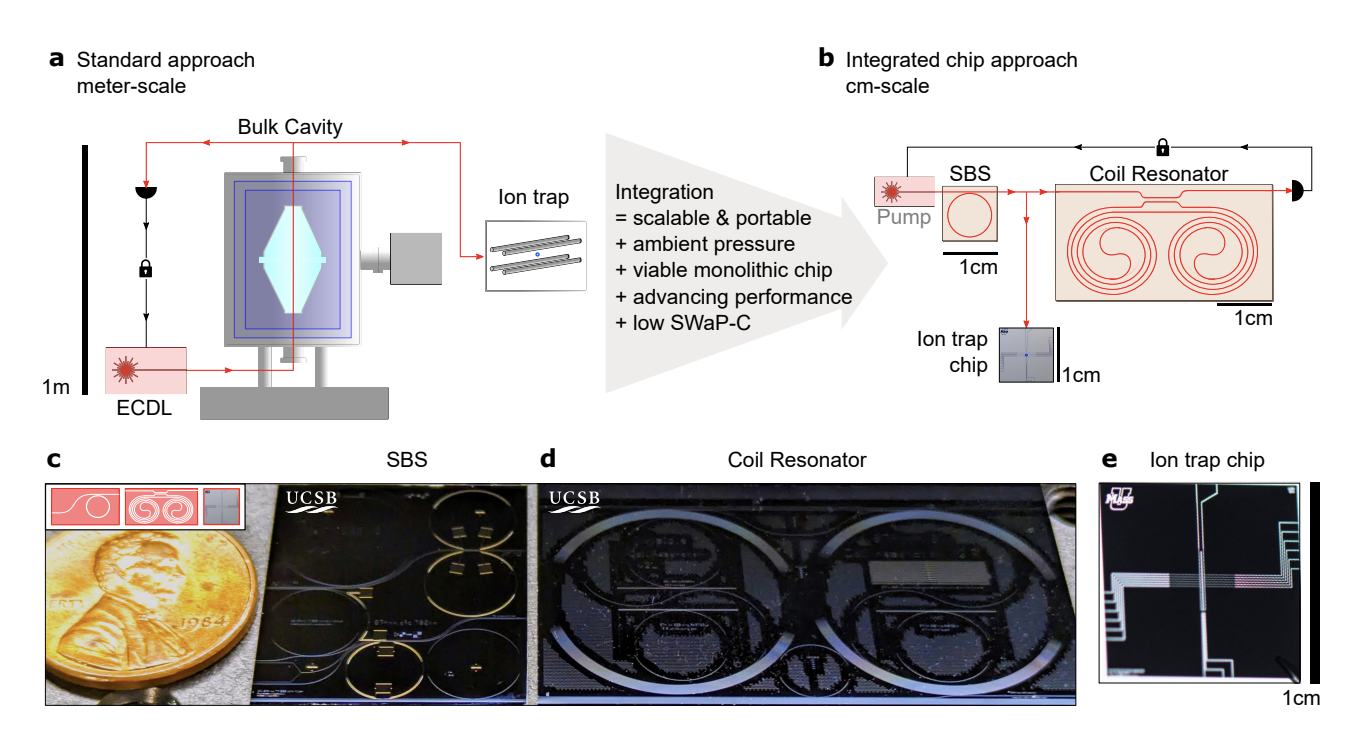The integration of ultralow noise visible light lasers into atomic systems is key for quantum information sciences. Current ion-based systems rely on large, lab-scale precision lasers, limiting their size and portability. The first demonstration of chipscale optical clock and qubit operations on a trapped ion has been reported, using a photonic integrated direct-drive visible wavelength Brillouin laser. This advancement could lead to the development of portable trapped-ion quantum sensors and clocks. However, the miniaturization of precision optical laser systems and moving these components closer to the trap itself has yet to be demonstrated.
What is the Significance of Integrating Ultralow Noise Visible Light Lasers into Atomic Systems?
The integration of precise, stable, ultralow noise visible light lasers into atomic systems is crucial for the advancement of quantum information sciences and the improvement of scalability and portability. Trapped ions are a primary method for high-fidelity quantum computing, high-accuracy optical clocks, and precision quantum sensors. However, current ion-based systems depend on bulky, lab-scale precision lasers and optical stabilization cavities for optical clock and qubit operations. This dependence limits the size, weight, scalability, and portability of atomic systems.
The chipscale integration of ultralow noise lasers and reference cavities operating directly at optical clock transitions and capable of qubit and clock operations would represent a significant transformation in atom and trapped ion-based quantum technologies. However, achieving this goal has been challenging.
What is the First Demonstration of Chipscale Optical Clock and Qubit Operations on a Trapped Ion?
The first demonstration of chipscale optical clock and qubit operations on a trapped ion has been reported. This was achieved using a photonic integrated direct-drive visible wavelength Brillouin laser stabilized to an integrated 3-meter coil-resonator reference cavity and the optical clock transition of a 88Sr ion trapped on a surface electrode chip.
For the first time, to the best of our knowledge, trapped-ion spectroscopy and qubit operations such as Rabi oscillations and high fidelity 99% qubit state preparation and measurement (SPAM) were demonstrated using direct drive integrated photonic technologies without bulk optic stabilization cavities or second harmonic generation.
How Does the Chipscale Stabilized Brillouin Laser Perform?
The chipscale stabilized Brillouin laser exhibits a 6 kHz linewidth with the 0.4 Hz quadrupole transition of 88Sr and a self-consistent coherence time of 60 µs via Ramsey interferometry on the trapped ion qubit. Furthermore, the stability of the locked Brillouin laser was demonstrated to 5 10^13τ at 1 second using dual optical clocks.
These results, facilitated by the low thermal-refractive noise 3-meter coil-resonator cavity and the ultralow loss CMOS foundry compatible silicon nitride integration platform, pave a direct path towards monolithic integration of stabilized lasers within trapped ion chips.
What Does This Advancement Mean for the Development of Portable Trapped-Ion Quantum Sensors and Clocks?
This advancement toward the development of portable trapped-ion quantum sensors and clocks heralds an era of portable quantum technologies. Trapped ions are a fundamental technology platform for quantum information sciences, enabling quantum information processors, optical clocks, precision quantum-logic spectroscopy, and quantum sensors.
Experiments based on ion trap technology employ a physics package that contains the ion trap and external laser and optical infrastructure used in the process of ion cooling, manipulation, interrogation, and readout. Today’s optical infrastructure occupies table tops and racks of equipment and supports functions including light generation and stabilization, beam control and delivery to the ion, modulation, detection, and control with light delivered to the trapped ion using optical fiber and free space optics.
What are the Limitations of Current Optical Infrastructure and How Can They Be Overcome?
The volume and size of current optical infrastructure add to the size, weight, and cost of trapped-ion systems, but it also limits reliability, scalability, and even experimental precision and performance, particularly through the generation and accumulation of laser phase noise as light reaches the ion.
There has been great success in miniaturizing the trapped ion physics package, and already trapped ion qubit systems are some of the smallest quantum computing systems in the world. However, the miniaturization through integration of the remaining system volume comprised of precision optical laser systems and moving these components closer to the trap itself has yet to be demonstrated.
Recently, many other functions necessary for ion trap operation have been monolithically integrated into the surface electrode trap (SET), such as detection, control electronics, and optical beam delivery. There has also been success miniaturizing the ultrahigh vacuum chamber, which houses the SET. However, two of the most fundamentally limiting optical subsystems today in terms of size, power, complexity, and reliability are the precision low phase noise laser and the large ultralow expansion optical cavity necessary to narrow the linewidth and stabilize the laser. These two subsystems constitute the stabilized laser, which is particularly important for optical clock and qubit operations, and even in compact trapped ion systems, more than half of the volume is comprised of the laser and optics systems.
Publication details: “Trapped ion qubit and clock operations with a visible wavelength
photonic coil resonator stabilized integrated Brillouin laser”
Publication Date: 2024-02-26
Authors: Nitesh Chauhan, Christopher G Caron, Jiawei Wang, Andrei Isichenko, et al.
Source: arXiv (Cornell University)
DOI: https://doi.org/10.48550/arxiv.2402.16742

